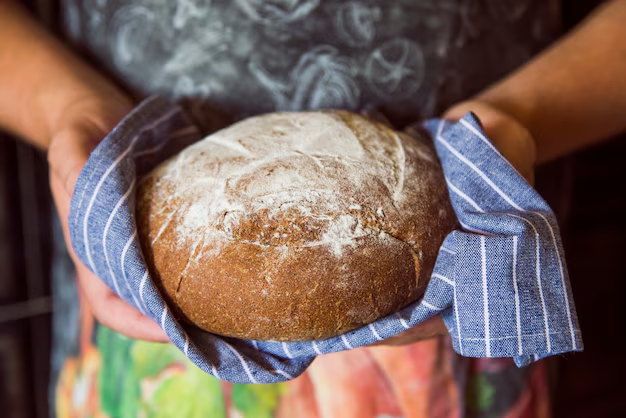Is Storing Bread in the Fridge a Good Idea? 🤔
Bread is a staple in many kitchens around the world, cherished for its versatility, nutrition, and taste. Yet, a persistent question remains: Is the refrigerator its ideal home, or should we stick with the bread box? Understanding the nuances of bread storage is essential to preserving its quality and shelf life. Let's dive into this topic and unravel this bread storage mystery.
The Science of Bread and Staling
Before deciding on the best storage method, it's important to understand why bread goes stale. Staling is not merely the bread drying out; it's a complex process largely due to retrogradation. When bread bakes, the starch molecules gelatinize, absorbing water and softening the crumbs. Once it cools, water begins to redistribute, and starch crystallization sets in, leading to the firm texture associated with stale bread.
Why Bread Stales Faster in the Fridge
Putting bread in the fridge may seem logical as it slows down mold growth. However, the cold temperatures accelerate the recrystallization of starch molecules, making bread go stale much faster than if it were stored at room temperature in an airtight container.
Pros and Cons of Refrigerating Bread
Pros
- Mold Prevention: Bread kept in the fridge lasts longer in terms of mold, as molds thrive in warm, humid conditions.
- Extended Shelf Life: If staleness isn't an immediate concern due to planned toasting or reheating, refrigerated bread can last longer without spoiling.
Cons
- Accelerated Staleness: As mentioned, the refrigerator crystallizes starch molecules faster, leading to a less desirable texture.
- Loss of Freshness: Bread's aroma and flavor can diminish over time in the refrigerator, affecting the overall sensory experience.
Best Practices for Refrigerating Bread
If refrigerating bread is unavoidable due to climate or personal preference, consider these tips:
- Use Airtight Containers or Wrapping: Keeping bread sealed can reduce moisture loss and slow staling.
- Slice Before Storage: If intending to freeze or refrigerate bread, slice it first. This allows you to grab what you need without exposing the whole loaf to air repeatedly.
- Toast or Warm Before Use: Give refrigerated bread a new lease of life by toasting or briefly warming it to rediscover its softness and flavor.
Alternative Bread Storage Methods
Room Temperature
Storing bread at room temperature is usually the best method for maintaining ideal texture and flavor, especially if the bread will be consumed within a few days.
- Bread Boxes: While preventing mold longer than airtight containers, bread boxes allow a bit of air circulation, which can help preserve crusty textures.
- Paper Bags: These allow a balance between air exposure and containment, keeping the crust crisp and the crumb moist.
Freezing
For long-term storage without compromising taste, freezing is an excellent option.
- Wrap Well: Use plastic wrap or aluminum foil, followed by a freezer bag, to prevent freezer burn.
- Slice Before Freezing: As with refrigeration, this helps you avoid unnecessary thawing.
Tips for Freezing Bread
- Defrost Gradually: Allow frozen bread to thaw completely in its wrapping at room temperature to avoid condensation forming on the crust.
- Rewarm for Best Results: A quick spin in the oven or toaster can revive frozen, thawed bread beautifully.
Bread Type Considerations
Not all bread is created equal—different types have varying storage needs.
Artisan Breads
- Crusty Varieties: These loaves, rich in moisture and flavor, are best enjoyed fresh. Store in a paper bag or bread box to maintain their crusty exterior.
Pre-Sliced or Commercial Bread
- Preservatives: These loaves may have preservatives that extend shelf life at room temperature, making them more tolerant to various storage methods.
Whole Grain and Seeded Breads
- Higher Moisture Content: These are prone to quicker spoilage. Refrigeration can lengthen their life but with a trade-off in texture.
Preserving Bread’s Freshness: Summary Tips 🥖
- Do Not Refrigerate: Generally, avoid refrigeration to prevent rapid staling.
- Store at Room Temperature: Use a bread box or paper wrapping for short-term storage.
- Opt for Freezing: For long-term storage, freeze sliced bread with proper wrapping.
- Reheat to Refresh: Toast or warm bread from the fridge/freezer to restore its original characteristics.
Conclusion: Making Your Choice
Deciding whether to refrigerate bread depends on your priorities—freshness versus longevity. For the freshest taste and texture, stick with room temperature storage and consume within a brief period. For those needing to prolong the shelf life, especially in humid conditions, freezing remains your friend. Whichever option you choose, understanding the science and nuances of bread storage will ensure every slice is as fresh as possible.
